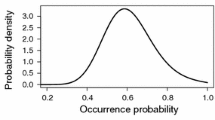Conclusions
A study of the literature to which this essay is an introduction will convince the student that statistics have been applied to the most varied ecological problems, often needlessly, and sometimes on false assumptions. It is a literature remarkable for its prolixity, but from its pages there emerge methods which are new to biology and which prove valuable in the difficult study of plant distribution. It must be left to the future to decide in what measure these methods can advance botany.
Similar content being viewed by others
Bibliography
Arrhenius, O. Distribution of species over the area. Meddl. Kgl. Vet. Nobelinst.4: 1920.
—. Species and area. Jour. Ecol.9: 95. 1921.
—. Statistical investigations on the constitution of plant associations. Ecology.4: 68. 1923. (The formula set forth in these papers has been examined by Gleason, and demonstrated to be unsound.)
Ashby, E. Quantitative methods in the analysis of vegetation. Proc. Linn. Soc.146: 30. 1933.
—. The quantitative analysis of vegetation. Ann. Bot.49: 779. 1935. (Contains an examination of the methods advocated by the Uppsala school, and the mathematical basis of a new method of analysing species distribution.)
Blackman, G. E. An ecological study of closely cut turf treated with ammonium and ferrous sulphates. Ann. Appl. Biol.19: 204. 1932. (Examples of the application of the percentage area method.)
—. A study by statistical methods of the distribution of species in grassland associations. Ann. Bot.49: 749. 1935. (Contains applications of Poisson series to distributions and a critical analysis of the various statistical methods in vogue.)
Braun-Blanquet, J. Pflanzensociologie. Leipzig. 1927.
Clapham, A. R. The form of the observational unit in quantitative ecology. Jour. Ecol.20: 192. 1932.
—. Over-dispersion in grassland communities and the use of statistical methods in plant ecology. Jour. Ecol.24: 232. 1936.
Clements, F. E. Research methods in ecology. Lincoln. 1905. (First account of the quadrat method.)
Cowles, H. C. The physiographic ecology of Chicago. Bot. Gaz.31: 73. 1901.
Fisher, R. A. Statistical methods for research workers. London, 1934.
Emmett, H. E. G. andAshby, E. Some observations on the relation between hydrogen ion concentration of the soil and plant distribution. Ann. Bot.48: 869. 1934. (Demonstrates that the apparent optimum pH for a species may be due to the distribution of pH values themselves.)
Gleason, H. A. The relation between species and area. Ecology3: 158. 1922.
—. Species and Area. Ecology6: 66. 1925. (Contains criticisms of Arrhenius’s formula.)
Hanson, C. andBall, W. S. An application of Raunkiaer’s Law of Frequency to grazing studies. Ecology9: 67. 1928.
Hanson, C. A comparison of methods of botanical analysis of native prairie in western North Dakota. Jour. Agr. Res.19: 815. 1934.
Jaccard, P. Lois de distribution florale dans la zone alpine. Bull. Soc. Vaud.38: 69. 1902.
—. Nouvelles recherches sur la distribution florale. Bull. Soc. Vaud.44: 223. 1908. (Applications of the coefficient of community.)
Kylin, H. Ueber Begriffsbildung u. Statistik in der Pflanzensociologie. Bot. Not.2: 81. 1926. (An extensive mathematical treatment of the problems of statistical ecology; a very important paper.)
Levy, B. andMadden, E. A. The point method of pasture analysis. New Zealand Jour. Agr.46: 267. 1933.
Lindquist, B. Den Skandinaviska Bokskogens Biologi. Akademiskh Avhandling. Stokholm, 1931.
Livingston, B. E. and Shreve, F. The distribution of vegetation in the United States in relation to climatic conditions. Carnegie Pub. 284. 1921.
McGinnes, W. G. The relationship between frequency index and abundance as applied to plant population in a semi-arid region. Ecology15: 263. 1934. (Embodies data which indicate homogeneity in the distribution of semi-desert vegetation.)
Morgan, A. andBeruldsen, E. T. Sampling technique as applied to irrigated pasture, etc. Jour. Dept. Agr. Victoria29: 36. 1931.
Moss, C. E. The vegetation of the Peak District, Cambridge, England, 1913.
Nordhagen, R. Om homogenitet, konstans, og minimareal. Nyt. mag. f. naturvid. 60: 1922. (One of the first publications exposing the fallacies of the Uppsala school.)
Osvald, H. Die Vegetation des Hochmoores Komosse. Akademische Abhandlung. Uppsala, 1923.
Pavillard, J. The present status of the plant association. Bot. Rev.1: 210. 1935.
Pearsaia, W. H. The statistical analysis of vegetation. Jour. Ecol.12: 135. 1924.
Raunkiaer, C. Life forms and statistical plant geography. Oxford, 1934.
du Rietz, G. E., Fries, T. C., Osvald, H. and Tengwall, T. A. Gesetze der Konstitution natürlicher Pflanzengesellschaften. Vetensk. ock. pract. unders: i. Lappland, etc. Flora och Fauna, 7: 1920.
du Rietz, G. E. Zur methodologischen Grundlage der modernen Pflanzensociologie. Ak. Avh. Uppsala, 1921.
-. Ueber das Wachsen der Anzahl der konstanten Arten & c. Bot. Not. 1922, p. 17.
—. Vegetationsforschung auf sozionsanalytischer Grundlage. Abderhalden’s Handbuch der biologischen Arbeitsmethoden.11: V, 293. 1930.
Shantz, H. L. A study of the vegetation of the mesa region east of Pike’s Peak. Bot. Gaz. 42: 1906.
Shantz, H. L. and Marbut, C. F. The vegetation and soils of Africa. Amer. Geog. Soc. Res. Ser. 13. New York, 1923.
Stapledon, R. G. Pasture problems: drought resistance. Jour. Agr. Sci.5: 132. 1912–13. (An early description of the weight-productivity method of determining botanical composition.)
Svedberg, T. Et bidrag till de statistika metodernas användning inom växtbiologien. Svensk. Bot. Tidskrift16: 1. 1922. (Critique of the minimal area method of analysis.)
Tansley, A. G. Types of British vegetation, Cambridge, England, 1911. (An example of the “conventional” method of describing and classifying vegetation, which, in the author’s opinion, is still the only practicable method.)
Watt, A. S. On the ecology of British beechwoods. Jour. Ecol.11: 1. 1923;12: 145. 1924;13: 27. 1925.
Wiehe, P. O. A quantitative study of the influence of tide upon populations ofSalicornia Europea. Jour. of Ecol.23: 323. 1935.
Author information
Authors and Affiliations
Rights and permissions
About this article
Cite this article
Ashby, E. Statistical ecology. Bot. Rev 2, 221–235 (1936). https://doi.org/10.1007/BF02867930
Issue Date:
DOI: https://doi.org/10.1007/BF02867930




